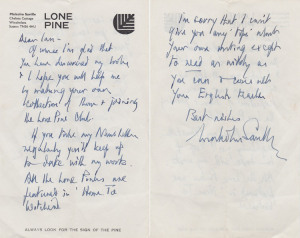Ian Sutherland's Blog: Ian's Blog, page 5
January 21, 2014
5 Ways Computer Hackers Remain Anonymous

January 15, 2014
My Jeffery Deaver Moment
And like all clichés, they have their basis in reality. Well, I’ve just experienced one. And as a result I’m feeling very writerly!
Writers fill up their minds with so much stuff they may or may not use. The collect and store whole scenes, single images, lines of dialogue, turns of phrase, character names and all sorts in their head. And as they write, sometimes it becomes time for one of those well nurtured ideas to make it onto paper. They’ve been hidden away for years, slowly gestating into something tangible, ready to be made real through words on a page. And ultimately they’ll be shared with the reader. Only the reader will never truly know the sheer depth of thought that went into that sentence, paragraph or even whole chapter.
And that’s just how it should be.
I’m at the closing stages of writing my debut novel and I’ve just drafted a chapter that’s been in my head for well over four years. I’ve imagined it in all sorts of different ways. It was always very visual and action packed with mini-cliffhangers in each section of the chapter. I’m an avid fan of Jeffery Deaver, the absolute master of this type of suspenseful writing, and, for me, I’ve always known this chapter was going to be my 'Jeffery Deaver' moment.

And now I’ve finally written it. In fact, on the page, the chapter is even better than in my various imaginings. Which is a great feeling. Very vindicating!
So, Mr Jeffery Deaver, if by some miracle you ever read this scene in my novel, I hope you appreciate it. I’ve certainly appreciated learning the craft of suspense from you.
My Jeffery Deaver Moment

January 9, 2014
The Indie Author’s Second Responsibility to Their Readers
The first responsibility any author has to their readers is obvious: write and publish a great book. That means it should be well written and if you're an indie author it should be professionally packaged (i.e. good cover, compelling blurb and have been through a proper copy-edit).
The second responsibility an indie author has to their readers is to engage with them. Engagement means striking up two-way conversations with readers and potential readers. It means making themselves easily contactable. It means being personable. It means initiating dialogue in the first place. It means using social media properly, whether you like it or not. It means giving more of yourself to your readers than you might be naturally comfortable with.
Many readers who have invested eight hours or more in reading an indie author's novel have expectations that are different to the expectations they might have of an author represented by a publishing house. Many expect to interact with the author via email, Twitter or other forms of social media. They expect to be replied to as an individual. They expect to be kept up-to-date. They expect to be informed as to what goes on behind the scenes in the author's life as a writer. The expect the personal touch.
Readers know that traditionally published authors often hide behind their publishing houses and literary agents. The contact details of these authors are usually brokered via someone else. Management of the author's website and Facebook page may be delegated to a lackey in the publishing house's marketing department. At best there will be a Twitter account that may actually be the real author, which will be obvious if the tweets are conversational and not promotional. Readers are fully aware that personal interactivity with traditionally published authors is minimal and rare.
Of course, there are many, many exceptions. And those traditionally published authors that engage personally with their readers form incredibly long-lasting relationships. Such relationships will survive most things: overly-critical critics, poor reviews, genre changes, a year or two off, key characters being killed off or even supposedly dead characters being brought back again.
Authors can have a major impact on their readers lives by engaging with them. Let me give you an example of one such reader.
Me.

As a child, I was completely enamoured with the Lone Pine series of books written by the late Malcolm Saville, about the adventures of a group of post-wartime children, mostly set in Shropshire or Kent. I was so taken that I felt compelled to write to the author. I've no idea what I wrote, but the publishing house must have forwarded it to Mr Saville who took the time to write a short letter back to me, in his own handwriting using a fountain pen. Here is the letter, one of the very few things I have kept from my own childhood. That's how much it meant to me.
Mr Saville engaged with me, one of his many readers, with a personal touch. Obviously, this was long before social media and email. But even back then, it was common knowledge that publishing houses often replied to readers' letters (especially from children) using pre-signed stock letters pretending to be from the author. Mr Saville chose the more personal approach and created a relationship with me that lasted right through all twenty Lone Pine books and many of the other seventy books he wrote before his death in 1982.
In this day and age, it's easier and quicker for authors to engage with readers. The most successful authors apply the personal touch in all their interactions with their readership. For indie authors, engagement with readers is mandatory for long-term success. For traditionally published authors engagement is clearly optional, perhaps delegating the responsibility to the publishing house marketing department for maintaining readership top-of-mind. However, if Malcolm Saville is anything to go by, personally engaging with readers is highly recommended whatever type of author your are.
January 7, 2014
The Indie Author’s Second Responsibility to Their Readers

December 16, 2013
Daily Cybercrime Newspaper Launched Today

November 18, 2013
Lessons Indie Authors Can Learn From Single-Estate Winemakers

November 1, 2013
3 reasons why Stornoway is currently a focal point for UK crime fiction

October 25, 2013
5 Different Applications of Narrative Motif Using the Simple Example of ‘Coffee’

Ian's Blog
- Ian Sutherland's profile
- 238 followers



